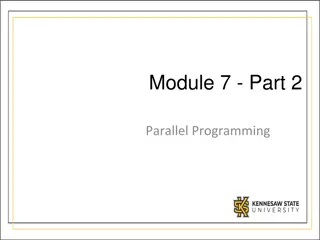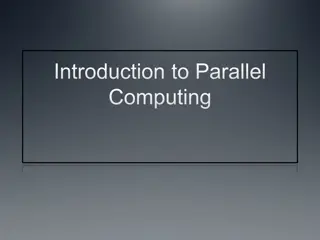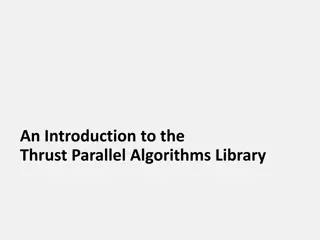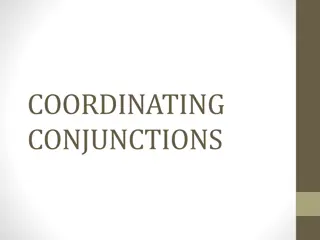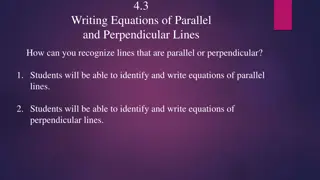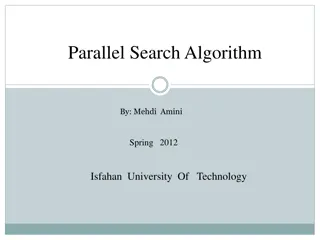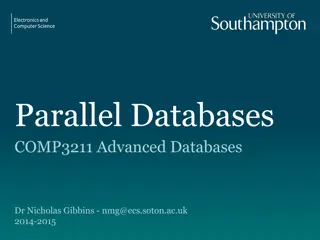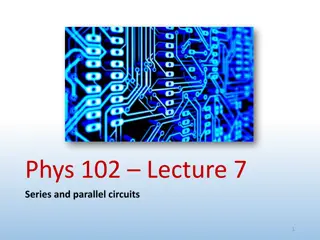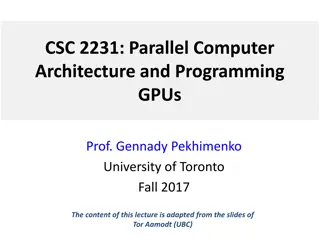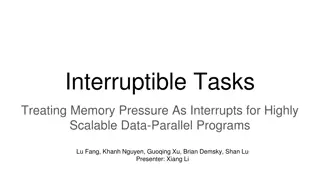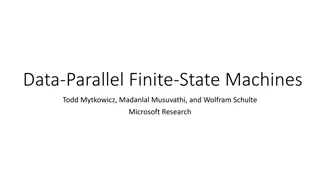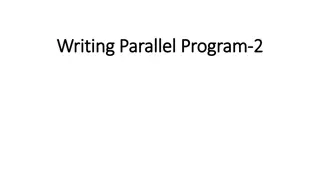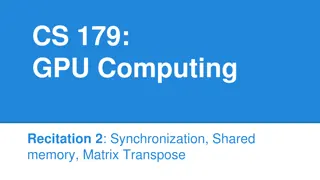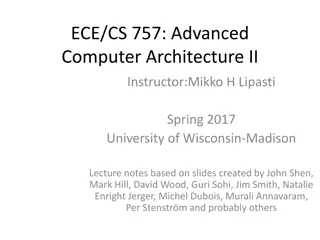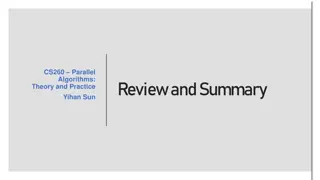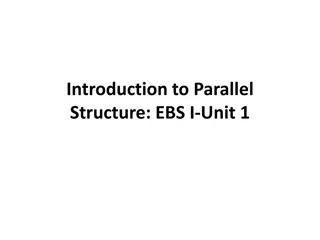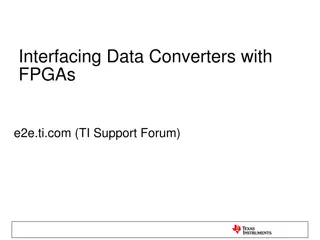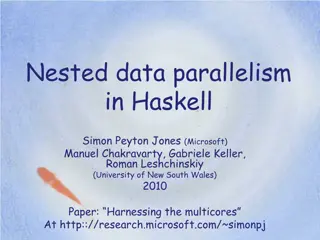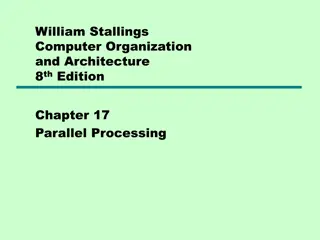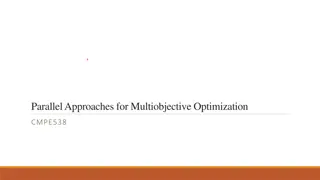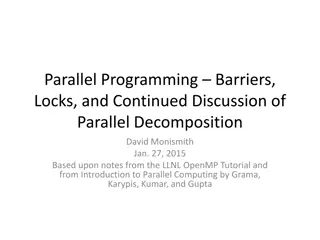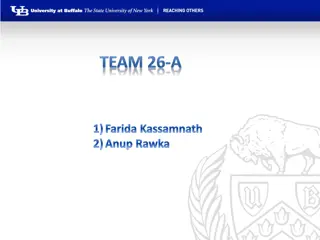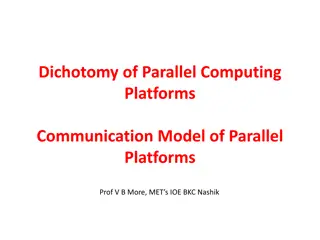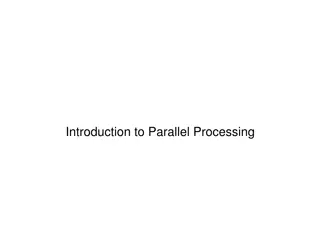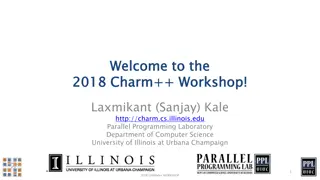Evolution of Parallel Programming in Computing
Moores Law predicted the doubling of transistor capacity every two years, benefitting software developers initially. However, hardware advancements can no longer ensure consistent performance gains. Parallel computing, leveraging multicore architecture, has emerged as a solution to optimize performa
7 views • 10 slides
Understanding 4-Bit Parallel Adder/Subtractor IC7483
Explore the concept of 4-bit parallel adder/subtractor using IC7483, which is a digital circuit capable of performing arithmetic operations on binary numbers greater than one bit in length. Learn about the structure, operation, and implementation of parallel adders with cascaded full adders. Discove
6 views • 11 slides
Exploring Parallel Computing: Concepts and Applications
Dive into the world of parallel computing with an engaging analogy of picking apples, relating different types of parallelism. Learn about task and data decomposition, software models, hardware architectures, and challenges in utilizing parallelism. Discover the potential of completing multiple part
0 views • 27 slides
Understanding Parallel and Distributed Computing Systems
In parallel computing, processing elements collaborate to solve problems, while distributed systems appear as a single coherent system to users, made up of independent computers. Contemporary computing systems like mobile devices, IoT devices, and high-end gaming computers incorporate parallel and d
1 views • 11 slides
Introduction to Thrust Parallel Algorithms Library
Thrust is a high-level parallel algorithms library, providing a performance-portable abstraction layer for programming with CUDA. It offers ease of use, distributed with the CUDA Toolkit, and features like host_vector, device_vector, algorithm selection, and memory management. With a large set of al
0 views • 18 slides
Understanding Transmission Modes in Computer Networks
Transmission modes in computer networks can be divided into serial and parallel modes. Parallel transmission allows multiple bits to be sent simultaneously over separate media, while serial transmission sends one bit at a time. The choice between serial and parallel transmission depends on factors s
0 views • 13 slides
Parallel Implementation of Multivariate Empirical Mode Decomposition on GPU
Empirical Mode Decomposition (EMD) is a signal processing technique used for separating different oscillation modes in a time series signal. This paper explores the parallel implementation of Multivariate Empirical Mode Decomposition (MEMD) on GPU, discussing numerical steps, implementation details,
1 views • 15 slides
Understanding Parallel and Distributed Systems in Computing
A parallel computer is a collection of processing elements that collaborate to solve problems, while a distributed system comprises independent computers appearing as a single system. Contemporary computing systems, like mobile devices and cloud platforms, utilize parallel and distributed architectu
0 views • 11 slides
Understanding Coordinating Conjunctions and Parallel Structure
Coordinating conjunctions like "and," "but," "or," and "nor" are used to connect words or phrases with similar grammatical functions. This creates parallel structure in sentences, ensuring clarity and cohesion. Using examples, the concept of parallel structure with coordinating conjunctions is expla
0 views • 19 slides
Understanding Parallel and Perpendicular Lines
Students will learn to identify and write equations of parallel and perpendicular lines by understanding the relationship between slopes. Parallel lines have the same slope, while perpendicular lines intersect to form right angles. Through examples and explanations, students will gain the skills to
0 views • 12 slides
Parallel Processing and SIMD Architecture Overview
Parallel processors in advanced computer systems utilize multiple processing units connected through an interconnection network. This enables communication via shared memory or message passing methods. Multiprocessors offer increased speed and cost-effectiveness compared to single-processor systems
2 views • 24 slides
Parallel Chi-square Test for Feature Selection in Categorical Data
The chi-square test is a popular method for feature selection in categorical data with classification labels. By calculating chi-square values in parallel for all features simultaneously, this approach provides a more efficient solution compared to serial computation. The process involves creating c
1 views • 4 slides
Understanding Shift Registers: Introduction and Classification
Explore the world of shift registers, including buffer registers, and different modes of operation like serial in/serial out, serial in/parallel out, parallel in/serial out, and parallel in/parallel out. Learn about the construction, operation, and classification of registers in digital systems.
1 views • 24 slides
Understanding Shift Registers in Sequential Logic Circuits
Shift registers are sequential logic circuits used for storing digital data. They consist of interconnected flip-flops that shift data in a controlled manner. This article explores different types of shift registers such as Serial In - Serial Out, Serial In - Parallel Out, Parallel In - Serial Out,
2 views • 9 slides
Understanding Parallel Circuits in Electronics
Explore topics such as resistors in parallel, voltage distribution, Kirchhoff's current law, resistance calculations, and practical applications in parallel circuits. Dive into problem-solving exercises and grasp concepts like current dividers, total resistance calculations, and power distribution i
0 views • 20 slides
Enhancing Internet Backbone Performance through Parallel Resolution of Packets and Rules
The bottleneck in Internet backbones lies in the decision-making process for incoming packets. This article explores the challenges faced in efficiently processing policies in routers and middleboxes by introducing parallel resolution techniques to increase throughput and reduce latency. It discusse
0 views • 22 slides
Understanding Parallel Sorting Algorithms and Amdahl's Law
Exploring the concepts of parallel sorting algorithms, analyzing parallel programs, divide and conquer algorithms, parallel speed-up, estimating running time on multiple processors, and understanding Amdahl's Law in parallel computing. The content covers key measures of run-time, divide and conquer
1 views • 40 slides
Efficient Resource Management for Multi-Agent System Execution on Parallel Architectures with OpenCL
This research focuses on efficiently managing memory and computing resources for executing multi-agent systems on parallel architectures using OpenCL. The study presents a hybrid approach involving population-level molecular virtual chemistry and individual-level virtual cells. The work enhances a p
1 views • 33 slides
Parallel Search Algorithm - Types and Approaches
Exploring parallel search algorithms in artificial intelligence, this study delves into various types like Sequential Depth First Search, Sequential Best First Search, and their parallel counterparts. The research outlines the process of searching for elements in initial and goal states, emphasizing
0 views • 24 slides
Understanding Parallel Databases and Their Impact on Performance
Explore the concept of parallel databases, how they address the I/O bottleneck, and their benefits such as increased scalability and improved application availability. Learn about parallel architectures and shared memory systems in advanced database design. Discover the importance of concurrency con
0 views • 80 slides
Electric Circuits: Series and Parallel Configurations Explained
In this lecture on electric circuits, we delve into series and parallel circuits featuring batteries, wires, resistors, and capacitors. Key concepts discussed include Kirchhoff's loop rule, series components, and equivalent resistance and capacitance. Learn how to simplify complex circuits and analy
0 views • 24 slides
Introduction to GPUs in Parallel Computer Architecture
This lecture discusses Parallel Computer Architecture and Programming GPUs, covering topics like the history of GPUs, the role of GPUs in parallel computing, and the evolution of GPU technology. It also highlights the use of GPUs for raster-based graphics, their programmability, and their significan
0 views • 12 slides
Managing Memory Pressure in Data-Parallel Programs
Addressing memory pressure in data-parallel programs is crucial to prevent performance degradation and out-of-memory errors. The solution lies in Interruptible Tasks (ITasks), a new type of data-parallel tasks that can be interrupted and memory reclaimed to optimize system scalability. Current chall
0 views • 24 slides
Data-Parallel Finite-State Machines: A Breakthrough Approach
This research discusses a new method for breaking data dependencies in data-parallel finite-state machines. It highlights the importance of FSMs in various algorithms and the need for parallel versions in processing large data sets. The study explores breaking data dependences with enumeration and t
0 views • 19 slides
Efficient Techniques for Writing Parallel Programs
Learn about writing parallel programs, thread processes, private and shared variables, rules for specifying variables, and static scheduling for optimized performance. Understand the concepts through code examples and best practices in parallel programming.
0 views • 13 slides
Parallel Programming Directives and Concepts
Learn about parallel programming directives like Diretiva.parallel and #pragma omp.parallel, which allow code to be executed by multiple threads simultaneously. Explore concepts such as defining parallel regions, setting the number of threads, and utilizing OpenMP directives for parallel for loops.
0 views • 39 slides
GPU Computing and Synchronization Techniques
Synchronization in GPU computing is crucial for managing shared resources and coordinating parallel tasks efficiently. Techniques such as __syncthreads() and atomic instructions help ensure data integrity and avoid race conditions in parallel algorithms. Examples requiring synchronization include Pa
0 views • 22 slides
Understanding Parallel Software in Advanced Computer Architecture II
Exploring the challenges of parallel software, the lecture delves into identifying and expressing parallelism, utilizing parallel hardware effectively, and debugging parallel algorithms. It discusses functional parallelism, automatic extraction of parallelism, and finding parallelism in various appl
0 views • 86 slides
CS260 Parallel Algorithms: Theory and Practice Review
This review covers essential topics from the CS260 Parallel Algorithms course by Yihan Sun, focusing on key concepts such as scheduler programs, cost models, reduce and scan techniques, PRAM models, atomic primitives, small algorithms, the master theorem, and sorting algorithms like Quicksort and Me
0 views • 25 slides
Mastering Parallel Structure in Business Communication
Understanding and implementing parallel structure in business communication is essential for clear, effective, and professional writing. Explore the nuances of parallelism, such as using correlative conjunctions like "not only...but also," to ensure consistency and coherence in your written work. Le
0 views • 21 slides
FPGA Data Converter Interfacing Overview
Explore various I/O formats for interfacing data converters with FPGAs, including ADC parallel and serial formats like CMOS, LVDS, DDR. Learn about clock edge alignment, parallel, and true serial formats. Understand the differences between SDR and DDR, as well as considerations for clocking and data
0 views • 32 slides
Implementing Parallel Testing Labs for Quality Control in Life Science Projects
Implementing parallel testing labs for quality control in life science projects involves creating new LJ charts, utilizing the right control charts, understanding how Statistical Quality Control (SQC) works, evaluating QC with a stable analytical system, and conducting parallel testing to ensure the
0 views • 17 slides
Overview of Nested Data Parallelism in Haskell
The paper by Simon Peyton Jones, Manuel Chakravarty, Gabriele Keller, and Roman Leshchinskiy explores nested data parallelism in Haskell, focusing on harnessing multicore processors. It discusses the challenges of parallel programming, comparing sequential and parallel computational fabrics. The evo
0 views • 55 slides
Overview of Parallel Processing Architectures
This comprehensive overview delves into the taxonomy of parallel processor architectures, including SISD, SIMD, MISD, and MIMD configurations. It explores the characteristics of each architecture type, such as single vs. multiple instruction streams and data streams. The images provided visually rep
0 views • 76 slides
Parallel Approaches for Multiobjective Optimization in CMPE538
This lecture provides a comprehensive overview of parallel approaches for multiobjective optimization in CMPE538. It discusses the design and implementation aspects of algorithms on various parallel and distributed architectures. Multiobjective optimization problems, often NP-hard and time-consuming
0 views • 20 slides
Understanding OpenMP Barriers and Locks in Parallel Programming
Exploring the concepts of OpenMP barriers and locks in parallel programming, this discussion covers the importance of synchronization through barriers, the use of lock variables for finer control over synchronization, and examples like the Dining Philosophers problem. Learn how these primitives faci
0 views • 22 slides
Enhancing Sorting Performance with Parallel Algorithms
Sorting is a crucial task in computer science, with data sizes increasing, parallel algorithms offer improved performance. This study explores enhancing Quick Sort using parallel computing, determining optimal processor numbers for efficiency gains.
0 views • 11 slides
Exploring Dichotomy of Parallel Computing Platforms
Dichotomy of Parallel Computing Platforms explores the communication model and control structures in parallel platforms, delving into the logical and physical organization as well as the levels of granularity for expressing parallelism. The discussion covers Flynn's Classical Taxonomy, classifying m
0 views • 60 slides
Understanding Parallel Processing Fundamentals
This overview delves into the basics of parallel computing, covering parallel memory architectures, programming models, design issues, and parallelizing serial programs. Parallel computing involves leveraging multiple compute resources simultaneously to enhance computational efficiency and solve pro
0 views • 35 slides
Introduction to Charm++ Programming Framework
Charm++ is a generalized approach to parallel programming that offers an alternative to traditional parallel programming languages like MPI, UPC, and GA. It emphasizes overdecomposition, migratability, and asynchrony to enhance parallel program performance and efficiency. The framework uses indexed
0 views • 43 slides
